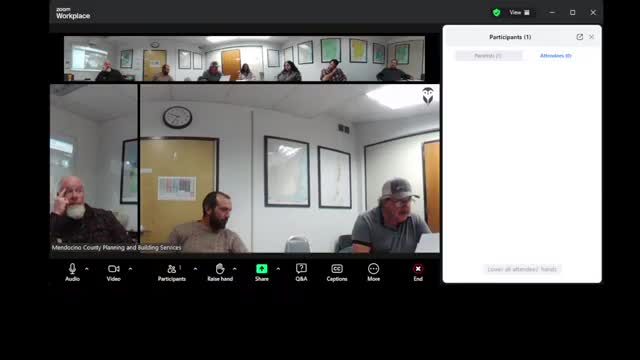Mendocino commission hears expert warning on Mediterranean oak borer threat
October 14, 2025 | Mendocino County, California
This article was created by AI summarizing key points discussed. AI makes mistakes, so for full details and context, please refer to the video of the full meeting. Please report any errors so we can fix them. Report an error »

Mike Jones, a University of California extension forester, told the Mendocino County Fish and Game Commission that the Mediterranean oak borer (MOB) is present in the county and poses a growing risk to valley oak and other native oaks. Jones said the pest has been detected in Napa and Sonoma counties and has been confirmed in Hopland and Potter Valley in Mendocino County.
Why it matters: Jones said MOB attacks large, older trees and can carry a symbiotic fungus that colonizes xylem and accelerates tree decline. He warned that the insect’s biology and year-round flight activity make early detection and targeted control difficult. Because the California Department of Food and Agriculture (CDFA) has ranked the species as a group B pest, Jones said state-level funding and quarantine actions have been limited.
Jones described the insect as an ambrosia beetle that carries and farms a fungus inside infested trees. "It's an ambrosia beetle," Jones said, explaining the beetle inoculates trees with a fungus that both larvae and adults feed on. He said infestations are often cryptic early on, starting in the upper canopy and then moving into main stems, and that by the time visible boring dust collects at a tree base the tree is often too far gone to save.
Jones summarized current local observations and research priorities: MOB was first recognized in the region in 2019, is established in multiple Northern California wine regions, and appears to prefer valley oak and other white oak species. He said the beetle appears especially damaging in drought- or urban-stressed trees. Possible local responses Jones described include outreach to avoid moving infested wood, research trials of insecticide and fungicide combinations, supplemental irrigation where feasible, and improving disposal practices for infested material.
Commission members asked about where the pest has been confirmed and whether state or federal agencies can help. Jones said CDFA’s group B classification reduced the likelihood of an aggressive state quarantine response and that much of the on-the-ground response for nonfederal landfall will fall to counties, cities and landowners. He encouraged keeping the matter on the commission agenda and said he has been in contact with tribes and local managers and can provide outreach materials and technical guidance.
The commission did not take a binding enforcement action at the meeting. Commissioners and the presenter discussed next steps including notifying county supervisors, staying in contact with CAL FIRE and tribal forestry programs, and continuing outreach and monitoring. No funding motion specific to MOB was approved at the meeting.
A speaker from the commission said they would help keep the issue on the county radar and consider inviting county supervisors or staff to future meetings for more formal discussion.
Why it matters: Jones said MOB attacks large, older trees and can carry a symbiotic fungus that colonizes xylem and accelerates tree decline. He warned that the insect’s biology and year-round flight activity make early detection and targeted control difficult. Because the California Department of Food and Agriculture (CDFA) has ranked the species as a group B pest, Jones said state-level funding and quarantine actions have been limited.
Jones described the insect as an ambrosia beetle that carries and farms a fungus inside infested trees. "It's an ambrosia beetle," Jones said, explaining the beetle inoculates trees with a fungus that both larvae and adults feed on. He said infestations are often cryptic early on, starting in the upper canopy and then moving into main stems, and that by the time visible boring dust collects at a tree base the tree is often too far gone to save.
Jones summarized current local observations and research priorities: MOB was first recognized in the region in 2019, is established in multiple Northern California wine regions, and appears to prefer valley oak and other white oak species. He said the beetle appears especially damaging in drought- or urban-stressed trees. Possible local responses Jones described include outreach to avoid moving infested wood, research trials of insecticide and fungicide combinations, supplemental irrigation where feasible, and improving disposal practices for infested material.
Commission members asked about where the pest has been confirmed and whether state or federal agencies can help. Jones said CDFA’s group B classification reduced the likelihood of an aggressive state quarantine response and that much of the on-the-ground response for nonfederal landfall will fall to counties, cities and landowners. He encouraged keeping the matter on the commission agenda and said he has been in contact with tribes and local managers and can provide outreach materials and technical guidance.
The commission did not take a binding enforcement action at the meeting. Commissioners and the presenter discussed next steps including notifying county supervisors, staying in contact with CAL FIRE and tribal forestry programs, and continuing outreach and monitoring. No funding motion specific to MOB was approved at the meeting.
A speaker from the commission said they would help keep the issue on the county radar and consider inviting county supervisors or staff to future meetings for more formal discussion.
View full meeting
This article is based on a recent meeting—watch the full video and explore the complete transcript for deeper insights into the discussion.
View full meeting
